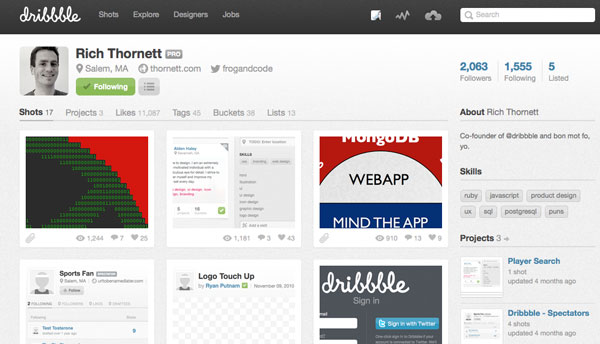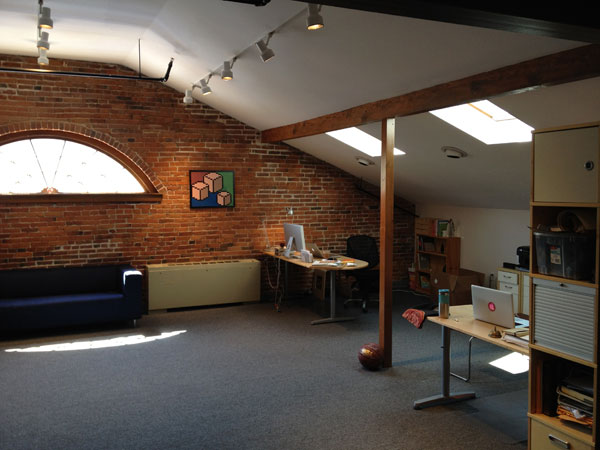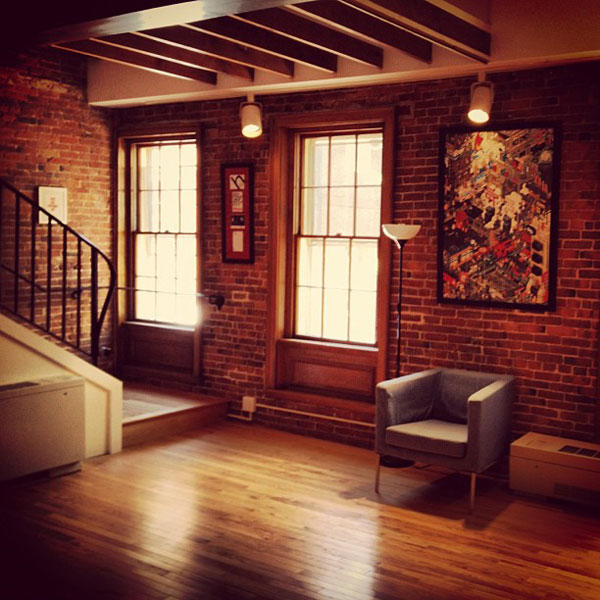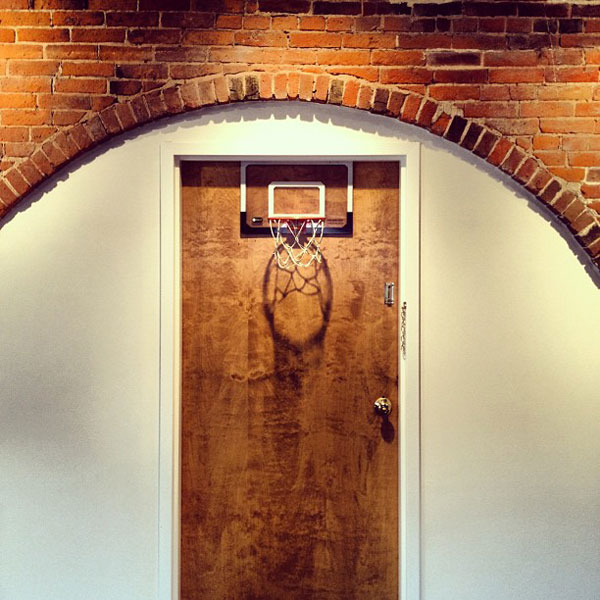One Minute With…
Rich Thornett

Hi Rich, thanks for taking time to chat with One Minute With. Tell us a little bit about yourself and your work.
I live and work in Salem, Massachusetts. I’m married to a wonderful, witty woman and have two beautiful-but-bonkers children. Professionally, I do product design and software development at Dribbble, a community where designers share screenshots of what they’re working on. It started out as a side project with my friend and neighbor, Dan Cederholm, and has turned into a full-time job and adventure for both of us.
Walk us through a typical day in the life of Rich Thornett.
My routine is pretty boring, but you asked… :)
I don’t have a boss and my office is a short walk from home, so in lieu of commuting, I hang out with my kids during the morning while they eat breakfast and get ready for school or camp. Lately, we’ve been reading Harry Potter during breakfast. (I told you this was exciting.) Having the flexibility to optimize my time with the kids has been one of the best things about working for myself.
Once they’re out the door, I exercise – typically I run or play basketball. Then I shower and head to work. So I get in a bit late, but I haven’t fired myself. Yet.
I spend the rest of the day working on all things Dribbble – responding to email (it’s frightening how much time I spend emailing of late), bug fixes, product planning, new development, and recently, carrying heavy things as we moved to a nifty new office that gives us room to grow.
When I get home at night, I hang out with my family – dinner, playtime, bedtime. I don’t have a lot of spare time for much else, but I’m a pro basketball junkie – I spend too much time reading basketball blogs – and I’m working through my Netflix queue. Breaking Bad and Supernatural are recent faves.

What led you to becoming a developer? Was there a defining point in your career, and if so, how did it shape you as a dev?
What led to me becoming a developer? The Web. I graduated from college in the mid-90s and took a few research assistant jobs out of school. I was very naive about careers and assumed I would do something in academia or research-related; that was all I knew. I was plodding through Excel spreadsheets when the Web came along and blew my mind. I decided to learn how to program and build web applications for a living.
I majored in Economics and Philosophy and had no background in computer science, so I had a lot to learn. I started teaching myself to code and enrolled in a Master’s program in Information Science. To this day I’m not sure what information science is, but it was a nascent discipline and, in large part, I was able to design my own curriculum around internet technologies and programming. I spent a ton of time in a very nice computer lab in Chapel Hill, North Carolina where I taught myself Perl, PHP, Java and SQL.
With more foresight, I would have gotten computer science training much earlier, but the master’s program got me immersed in application development. I shudder to think where my career would be had I not gotten caught in the Web.
As for a defining point in my career, I think it’s Dribbble. The site has gotten a lot of notoriety, but more personally, it reawakened the urge to OWN my work. I got into programming to build applications for problems I cared about and to craft solutions that reflected my values. After more than a decade of working at startups and blue chips, my biggest frustration has been seeing so many projects fail or fall short due to deficits of taste, will or decision-making by product owners; or by the absence of a product owner. Many companies fail to realize the importance of having someone with taste and judgment at the helm of a project, someone who understands the past, present and future of a product, and its relation to the business. As John Gruber put it: “The quality of any collaborative creative endeavour tends to approach the level of taste of whoever is in control of the project.”
I’m not good at visual design in the sense of choosing specific colors, type, etc, so I never thought of my self as a designer. But in every role I’ve had, I’ve been obsessed with copy, information design, feature selection, page layout, visual weight, messages and signals conveyed to users, application form and function, and business models. This, to me, is product design.
Playing that role is what I’ve loved most about working on Dribbble. Whatever the future holds, it’s difficult to imagine playing a role without that level of strategic input and authority. It’s truly thrilling.
Dribbble is a site built for a very creative, very web-savvy userbase. Do you think this makes it harder to work on, when you are under scrutiny from so many people with experience of developing similar platforms? Or does your community aid the development of Dribbble?
Good question. This is definitely a double-edged sword. Getting the word out about Dribbble, growing the site and having great content has definitely been aided by the fact that our users are so savvy and talented. But criticism can be very harsh, and there can be drama at times. I certainly have much thicker skin than I did when I started this project.
But overall, it’s a big win for Dribbble to have the community that we do. The site has been used by millions of people, it earns revenue that feeds our kids, and we’ve heard from many users that it’s changed their lives due to personal connections made and and work opportunities received. To get this kind of response to software we’ve built… it’s a pretty amazing thing. I’m eternally grateful to our members who make this thing go.

Obviously, Dribbble is a community-driven site. How does the way people use Dribbble now compare to how you and Dan initially conceived it? How do you think Dribbble will evolve, both as a site and as a community, in the future?
I guess this was naive in retrospect, but we had no idea there would be so much interest and drama around Dribbble’s Popular page. We created it when we had a small number of users as a simple entry point into the site – showing well-received work seemed like an obvious place to start for the uninitiated. We figured members would focus on their following page (a la Twitter), or exploring the site through tags, search and other browsing features. But, love it or hate it, a lot of people seem to care deeply about who and what appears on that page.
I think some see the Popular page as an endorsement of what is GOOD DESIGN, and when they disagree, they get upset. But it’s actually a reflection of what is trending. I’ve toyed with the idea of removing that page altogether, but not sure I’d survive the riot that ensues. We’re damned if we do, damned if we don’t at this point. But it’s damned interesting :)
From the extended basketball metaphor, to the fact that you and Dan use the site just as regularly as the users, Dribbble is very much a site with a personality. How important is it to you to keep yourselves from becoming a faceless company?
I think that Dribbble’s personality comes from a) our members and b) product decisions we make. We do participate in the community, but intentionally try to keep low profiles on the site (not always possible for Dan since he’s well-known). The site exists to feature its members and their work, not us.
It was important getting started that Dan’s name was attached to the project. It will always be important that we make good product design decisions with our user’s interests at the forefront. Does it matter that people know the names and faces of who’s behind the site, particularly as we grow? I don’t know. I think the key is to make sure the site is working well for users. As time passes, and as membership and our company grows, I suspect that the quality of the service we provide will matter much more than our names and faces.

If, in some Freaky Friday-like situation, you could live the life of another designer, illustrator, developer or creative, for a day, who would it be, and why?
I have a bit of a developer/designer crush on Shaun Inman. He’s a polymath who seems to excel at every aspect of product design. He has all sorts of interesting ideas for projects and teaches himself whatever it takes to build them. He’s a guy with great vision who’s been able to ship many successful products (Mint, Fever, The Last Rocket, etc).
Lately he’s been creating 8-bit iOS games, shots of which he posts on Dribbble – I’m always excited to see what he’s coming up with next. I’m not even a gamer, but his work is fascinating to me. I’d love to spend a day in his mind to see what he’s thinking about and working on.
What tools could you not live without?
Ruby, Ruby on Rails and the ecosystems they have spawned I’ve done web development in many languages. Ruby/Rails is the best thing that’s ever happened for webapps IMO. The combination of rapid application development and high quality practices that Rails ushered into the mainstream completely changed the game.
PostgreSQL
Best. Database Ever.
New Relic
Essential for monitoring web applications. (But don’t tell our biz contact over there.)
Google + Stack Overflow
Search is still the killer app for developers IMO. I can find the answer to any question, often in a matter of seconds, often on Stack Overflow.

And finally, what tips would you give to anybody who is looking to get started in the big bad world of web development?
Be strategic. As you learn, make it a goal that your code or designs get used. Side projects are a great way to learn, but they’re even better in the hands of users. It puts you in the position of learning to solve problems for _people_ and gets you visibility in the community.
The resume of designers and developers has evolved from paper to an amalgam of blog/Twitter/GitHub/Dribbble/LinkedIn/etc. But it’s easier than ever to build and deploy software products, so that should be part of your resume, too. Try to build something – or team up with someone to build it – that ultimately has a URL where people can use or see your work. Pointing people to your creations is tremendously satisfying and the best resume of all.
Thanks Rich!
Many thanks to Rich for sharing his thoughts with One Minute With. I really enjoyed his answers, and I hope you love the interview as much I do!
Why not check out Rich’s site, and follow him on Dribbble and Twitter?